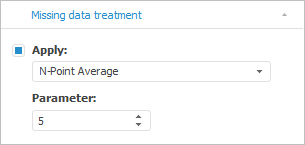 To display the tab
To display the tabTo select a missing data treatment method, use the Missing Data Treatment tab on the side panel. The list of options on the tab depends on the currently used calculation method.

If missing data treatment is required, select the Apply checkbox and select one of the methods:
Casewise. Default. Empty values are excluded from the series. They are ignored in the calculations.
Geometric Interpolation. Empty values of the series are calculated using geometric interpolation.
Cubic Spline Interpolation. Empty values of the series are calculated using cubic spline interpolation.
Linear Interpolation. Empty values of series are calculated using linear interpolation by two neighboring points.
Linear Trend. Linear trend is used to calculate empty values of series.
Previous Value. Empty values are replaced with the previous non-empty value.
Random Value. Empty values of series are replaced with a random number that belongs to the interval [minimum series value; maximum series value].
Succeeding Value. Empty series values are replaced with the succeeding non-empty value.
Average. Empty values of the series are calculated as average.
N-Point Average. Empty values of series are calculated as N-point average. Set the number of neighboring points (N) in the Parameter box.
Previous Growth Rate. Empty values of series are calculated based on growth rate of existing values in comparison with the previous period. Set the number of periods in the Parameter box.
Succeeding Growth Rate. Empty values of series are calculated based on growth rate of existing values in comparison with the succeeding period. Set the number of periods in the Parameter box.
Value. Empty values of series are replaced with the value selected in the Parameter box.
See also: